Summary
The US Geological Survey (USGS) predicts that many strategic metals will be in critical demand within the next 100 years and some within the next 30 years. In some cases, the concern about a lack of resources stems from government's inaccurate assessments of their own mineral resources. This lack of understanding means that reserve estimates often grow as more mines are opened: "in just 1 year, from 2009 to 2010, the USGS, increased its estimate of lithium resources from 13.8 to 25.5 Mt (1 Mt = 1 million tons)" (Gruber, 2011). Additionally, reserve projections often underestimate the contents of the earth's crust because lower ore grade deposits may not be considered a reserve (World Nuclear Association, 2012). Demand for elements varies by element group (see Table 1) and the variety of strategic elements results in a similar variety of supply problems. For some elements, such as the rare earth elements (REEs), the problem is production. Current mines are not sufficient to meet demand for all the metals, particularly dysprosium and neodymium (Vaccari, 2009) (see REE demand breakdown figure below). For other elements, such as uranium, the rare metals, phosphorus and platinum group elements (PGEs), production is less of a concern (Vaccari, 2009).
Current Demand Rates Varying by Element Group (Table 1):
| Element | Global Reserves (tonnes = t, kilograms = kg) | Current Yearly Demand |
| REEs | 110,000,000 t (USGS 2011) | 136,000 t (USGS 2011) |
| Platinum group elements | 48,000,000 kg (Wilburn, 2004) | 245,000 kg (Loferski, 2011) |
| Uranium | 5,327,200 t (Supply 2012) | 68,000 t (Supply 2012) |
| Phosphorus | 71,000,000 t (USGS, 2012) | 9,800,000 t (Schroder, 2010) |
| Lithium | 13,000,000 t (Gruber 2011) | 220,000 t (Gruber 2011) |
As an example, here is the REE demand breakdown by element in 2012 (Shaw, 2012)
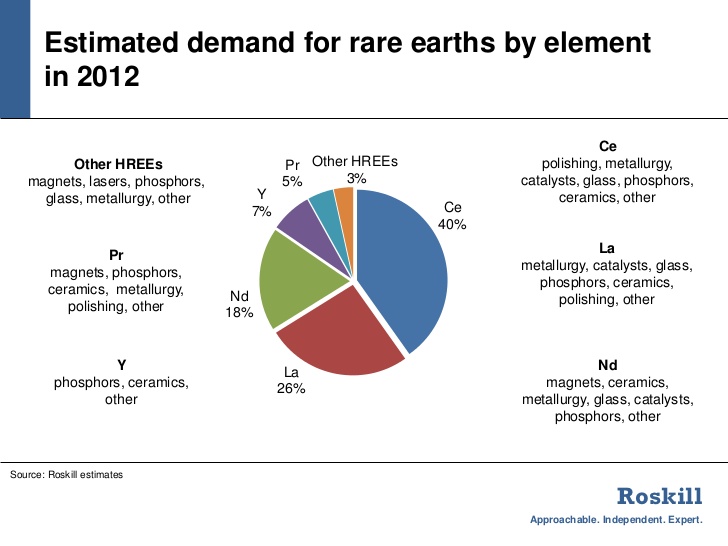
Source: http://image.slidesharecdn.com/globaldemandforrareearths-120831082456-
phpapp01/95/slide-5-728.jpg?1346419795
To alleviate the approaching shortage of many strategic elements, we suggest two approaches; opening new mines and increasing the productivity of existing mines. Locating more deposits to open new mines is more practical. However, an important part of our plan is to develop technologies that increase mining yield.
Currently, there are only a few mines that supply the entire world's demand for REEs and most of them are located in China. The largest REE mine in the world, Bayan Obo, alone provides 40-50% of all REEs. In 2010, Bayan Obo and other REE mines in China provided approximately 97% of the global supply (Humphries, 2012)
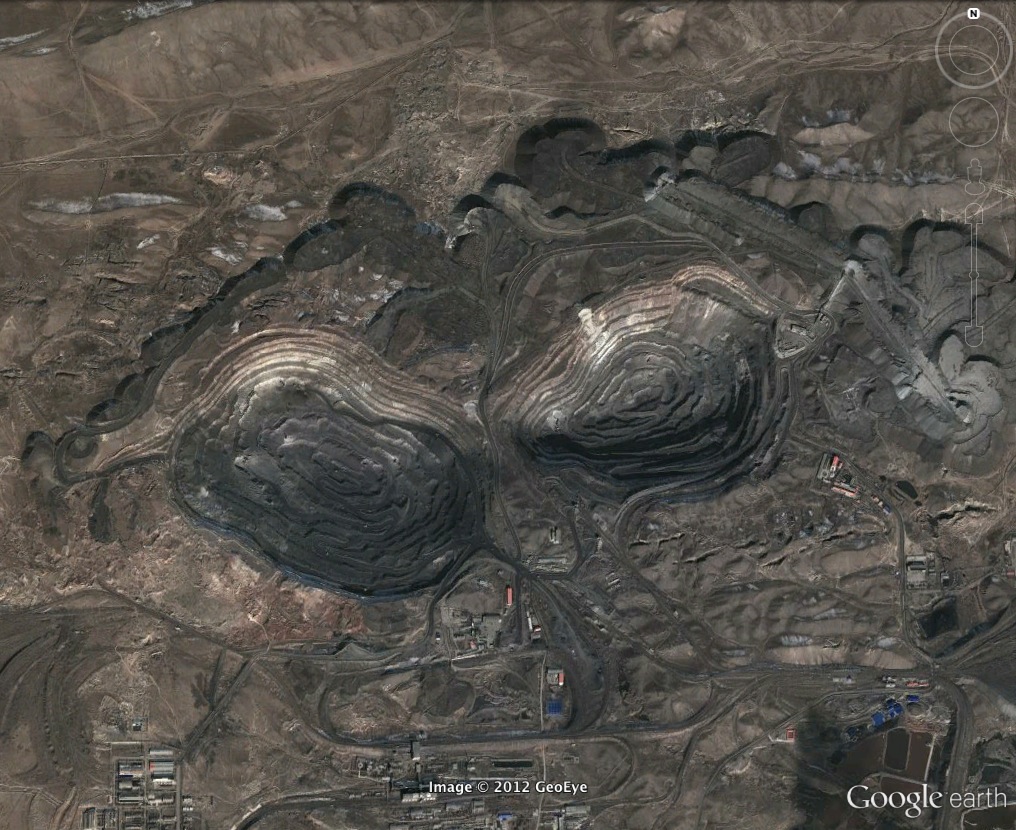
China no longer accounts for all of the global REE supply due to increased production in the rest of the world. There are only four REE-specific mines that exist outside of China, two of which opened in the past year (other mines worldwide only produce REEs as a byproduct). These other mines are Mountain Pass in the United States, Mount Weld in Australia, Lovozero in Russia, and Kerala in India. However, these mines are not the only locations of REE deposits.
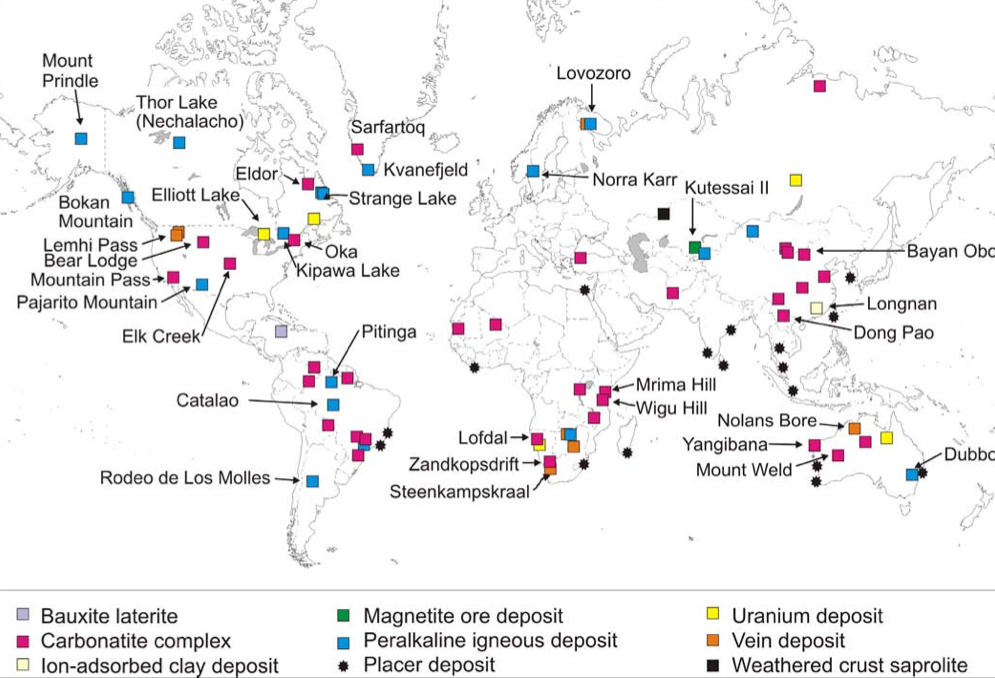
(Source: http://www.dggs.alaska.gov/webpubs/dggs/ic/text/ic061.PDF).
As the demand for REEs increases, it will become both necessary and more economically feasible to mine in other locations. Although many additional deposits of REEs have been discovered - and their economic feasibility debated by many countries - it will continue to become important to find new deposits. Private funding will continue to be focused on junior exploration companies in an effort to increase known reserves.
Geology
Rocks are composed of minerals, which are solid substances with a regular crystalline structure. Strategic elements are found as either major or minor constituents within the crystal lattice of minerals. Locations of minable elements can be determined by the deposits of the associated rocks and minerals which, when deposited in significant and refinable concentrations, are called ores. The location of elements varies based on the minerals of which they are part and the rocks that contain those minerals. The feasibility of extracting an element depends on the concentration and mineralogy of the element in the host mineral or rock. Mineral deposits form in a variety of complex geologic settings such as continental magmatic arcs, sedimentary basins, and evaporite deposits. The occurrence of a REE-enriched mineral does not necessarily correlate with economic feasibility of mining that mineral deposit; mining companies must also look at ore grade of the deposit to determine its profitability.
REEs
Most REEs are mined from placer deposits, bedrock, or clay formations (see map below for currently mapped deposits) (Orris, 2002). In the early period of mining REEs, they were mined primarily from placer deposits, which are mineral accumulations in rivers and on beaches. Placer deposits form when minerals are separated by density as lighter minerals remain suspended and more dense minerals are deposited along the riverbed. Bedrock and beach sand deposits constitute the locations of the largest mines. REE-rich minerals are generally found in either carbonatites or peralkaline granites and associated pegmatites. REE-enriched clay can be refined at a much lower cost but the concentration of REEs is much lower in these deposits .
The primary REE-bearing minerals are monazite (REE)PO4, bastnasite (REE)CO3F and xenotime (REE)PO4 (Beauford, 2010). Xenotime preferentially incorporates heavy rare earth elements (HREEs) while monazite incorporates light rare earth elements (LREEs). This is important because LREEs are much more readily available and therefore a xenotime deposit may be more valuable than a deposit of monazite. Bastnasite is found in carbonatites and pegmatites and refineries can acquire quantities of europium oxide, cerium, lanthanum, neodymium, and praseodymium from this mineral. Monazite is a mineral composed primarily of cerium, lanthanum, neodymium, yttrium, and phosphorus, depending on the specimen. Monazites typically contain high concentrations of radioactive elements such as uranium, thorium, and their intermediate decay products. REEs are also found in apatite and eudialyte, but the technology to feasibly refine REEs out of these minerals has yet to be developed. REEs can be found in clay deposits, where the elements are adsorbed onto the clay particles. This comprises a small percent of the total REE market, yet is important again because it provides some of the HREEs (Terry, 2011)

citation for map data: (Orris, 2002)
Phosphorus
Almost all phosphorus is mined as phosphate rock (PO4). Deposits are typically found in shales, cherts, limestone, dolomites and sandstone as well as hydrothermal veins or as chemically dissolved phosphate minerals in igneous and metamorphic rocks. One of the world's largest phosphate deposit is the Phosphoria Formation, located in southeast Idaho. The Phosphoria Formation is a part of the Western Phosphate Field which ranges from southern Montana to northern Utah. The Phosphoria Formation is composed of black shale deposits (Zapata, 2004). While primarily enriched with phosphorus, these deposits contain trace amounts of toxic elements like arsenic and selenium, which can be harmful to humans and animals (Hein, 2004). The top four phosphorus producers are the United States of America, China, Morocco and Western Sahara, and the Russian Federation. These four countries combined produce 72% of the world's phosphorous (Zapata, 2004).
Here is a map of all of the phosphorus deposits in the world:
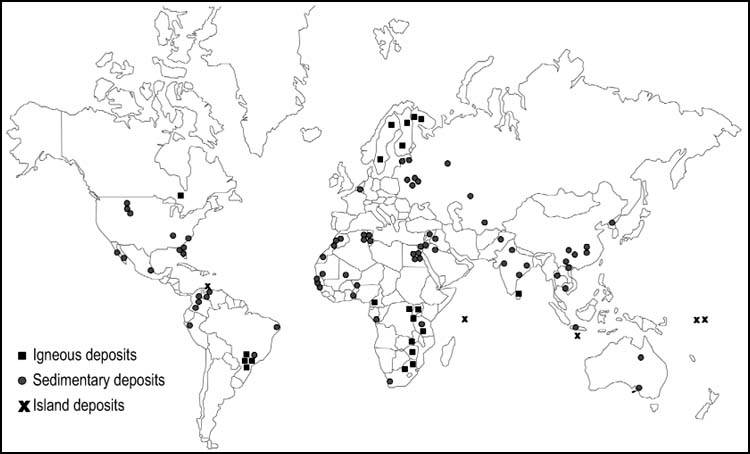
(Zapata, 2004)
Platinum Group Elements (PGEs)
Platinum group elements are mined from mafic and ultramafic igneous rocks, in alluvial and placer deposits, hydrothermal veins, and contact mineralization deposits. They also occur in the mineral cooperite and in igneous rocks (Pohl, 2011).
Here is a map of all PGE deposits in the world:
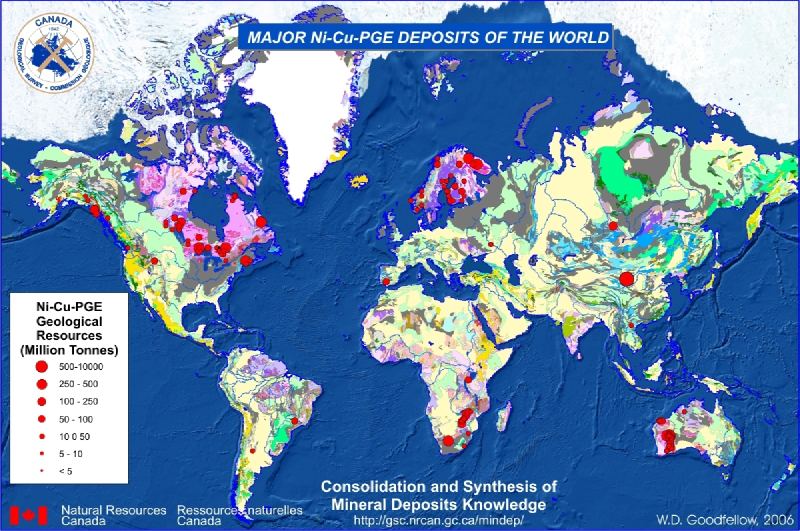
(Goodfellow, 2006)
Rare Metals (In, Ga, Zr, Nb, Co, Ta, Li)
Rare metals occur in a wide variety of deposits. Indium and gallium specifically are mined in zinc ores. Additionally, economically valuable concentrations of gallium can be found in bauxite, a sedimentary rock typically mined for aluminum. (Raymond, 1995) Zirconium is found in the silicate mineral zircon as well as many other common minerals. Zirconium is also produced as a byproduct of mining the titanium minerals ilmenite and rutile. Niobium and tantalum are commonly found in the minerals pyrochlore and columbite. Cobalt is mined specifically from ores like cobaltite, but also as a byproduct of copper and nickel mining (Raymond, 1995). Lithium is found in three main types of deposits: brines, pegmatites, and sediments. Brines (concentrations of highly saline water) are mined for lithium by pumping the liquid from large brine bodies into holding ponds for evaporation into salts, which are further processed (Topinka, 2007). Pegmatites (igneous intrusions with high concentrations of incompatible elements such as REEs) (Topinka, 2007), are first isolated from the ore through flotation, and then extracted by further processing. Pegmatites are more expensive to process than brine, but typically have higher ore concentrations (0.60%). Lithium is also extracted from sedimentary rocks, including clays, which can have up to 0.7% concentrations, but this is a much less common form of deposit than brines or pegmatites (Gruber, 2011).
Uranium/Thorium
Uranium and thorium are mined primarily from two deposits types. The first deposit type is placer deposits of uranium in sandstone, which are composed of uraninite and coffinite. Sandstone roll front deposits occur where oxidixed uranium is precipitated from groundwater when it encounters reducing conditions. The second important type of uranium deposits are unconformity-associated deposits, which are found between two rock bodies were a sandstone overlies an igneous or metamorphic basement. The minerals in unconformity deposits containing uranium are uraninite and pitchblende. Other deposits include hematite-breccia complex deposits, magmatic-hydrothermal uranium in iron-oxide Cu-Au deposits and quartz-pebble conglomerate deposits (World Nuclear, 2010). Thorium is mined in conjunction with uranium, so much that estimates of reserves for these elements are made based off of uranium content. Thorium is typically found in the minerals thorite, thorianite and monazite however monazite is the only mineral from which Thorium is currently mined. These monazite deposits are found in placer deposits. India and the United States currently have the most thorium deposits in the world (Pohl, 2011).
Uranium resources in the world:
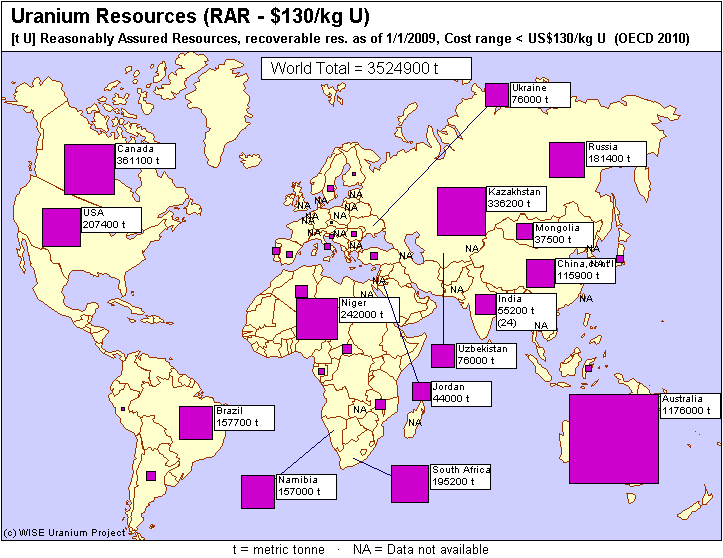
(Greenberg, 2012)
Thorium distribution in the world:
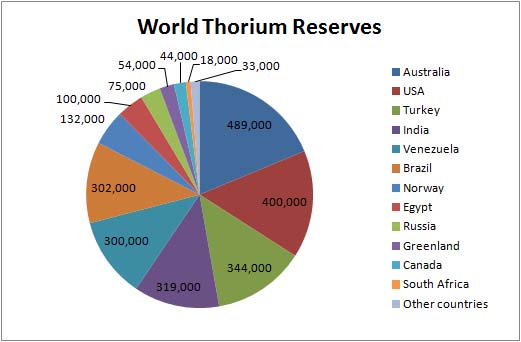
(Thorium Reactor Technology, 2012)
Global Reserve Maps
Below are several maps showing various elements and their reserve estimates. These maps indicate reserves for an entire country. However, sometimes the reserves are only located in specific locations within a country and not distributed evenly throughout. For instance, phosphorus deposits in the US mainly come from one mining location in Florida. Reserve estimates are taken up to a certain year (usually through 2010) and may underestimate the amount of reserves in a certain location. The lightest color corresponds to fewer reserves, while the darker color corresponds to more reserves. Each element varies in scale. More detailed numbers and estimates can be found in the links below the button.
Global Reserve Map for Cerium:
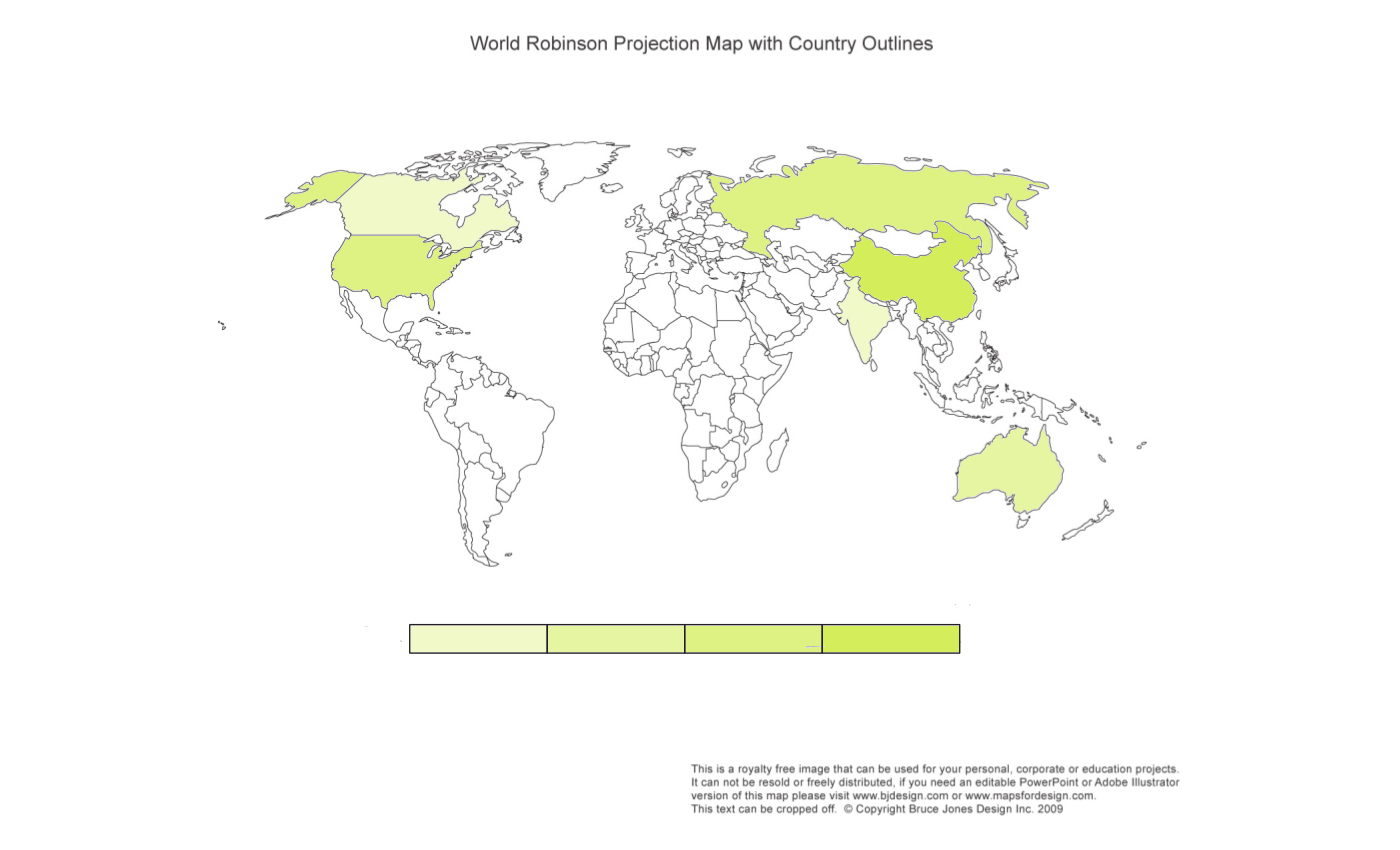
http://minerals.usgs.gov/minerals/pubs/commodity/rare_earths/740397.pdf
Global Reserve Map for Lithium:
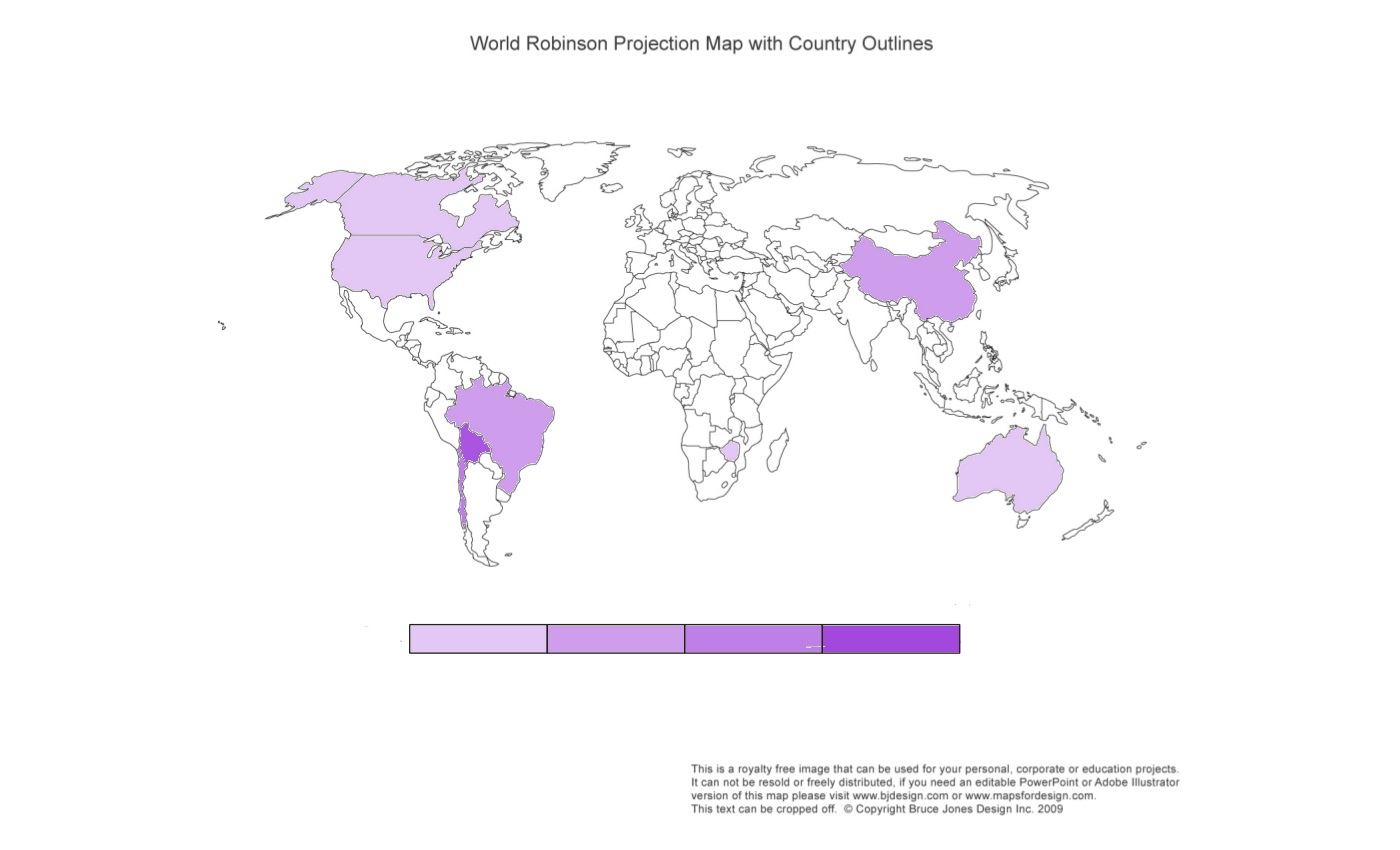
http://minerals.usgs.gov/minerals/pubs/commodity/lithium/lithimcs07.pdf
Global Reserve Map for Niobium (Columbium):

Niobium (columbium): http://minerals.usgs.gov/minerals/pubs/commodity/
niobium/mcs-2012-niobi.pdf
Global Reserve Map for Phosphorus:
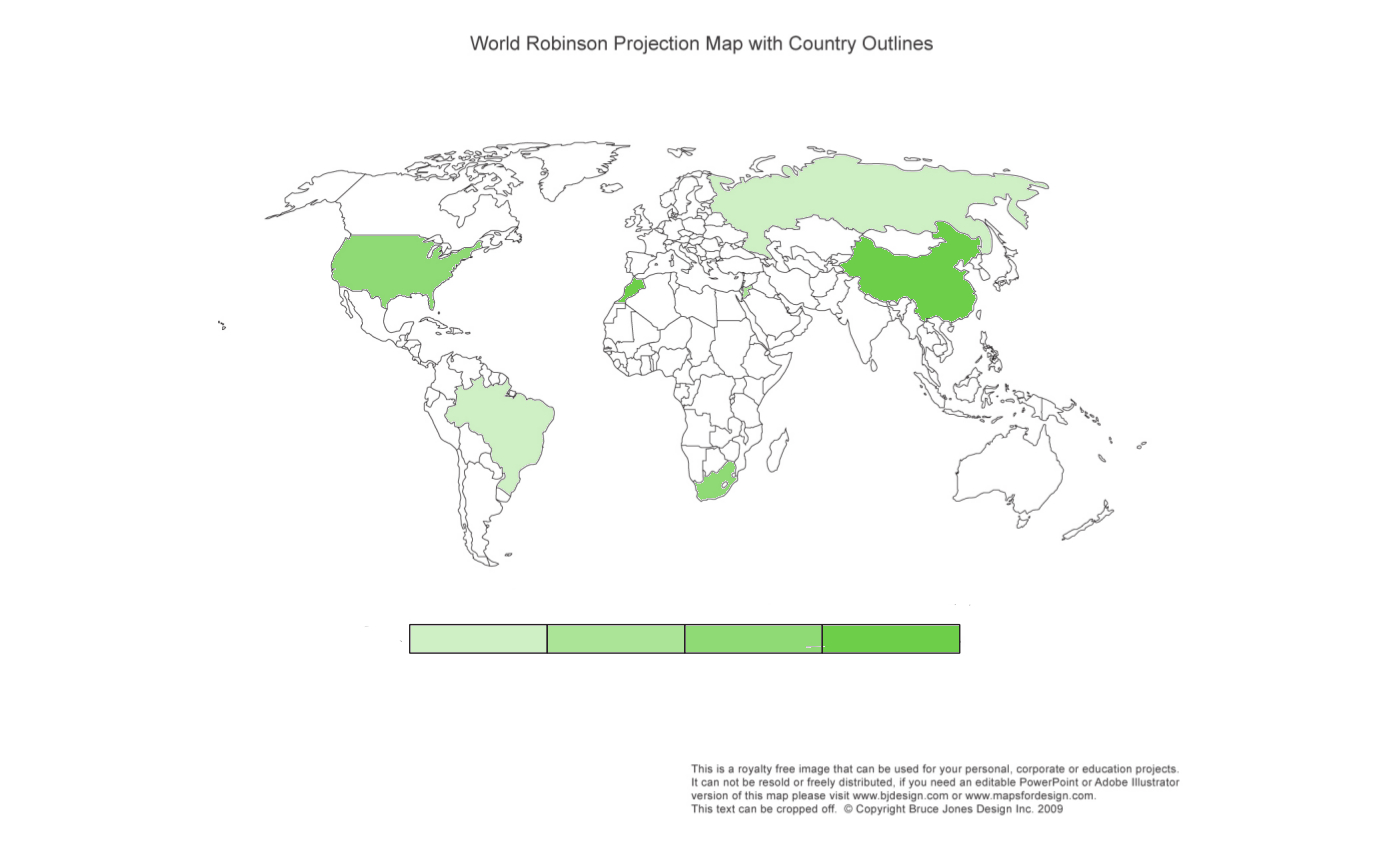
Phosphorus: http://web.mit.edu/12.000/www/m2016/pdf/scientificamerican0609-54.pdf
Global Reserve Map for Platinum group elements:
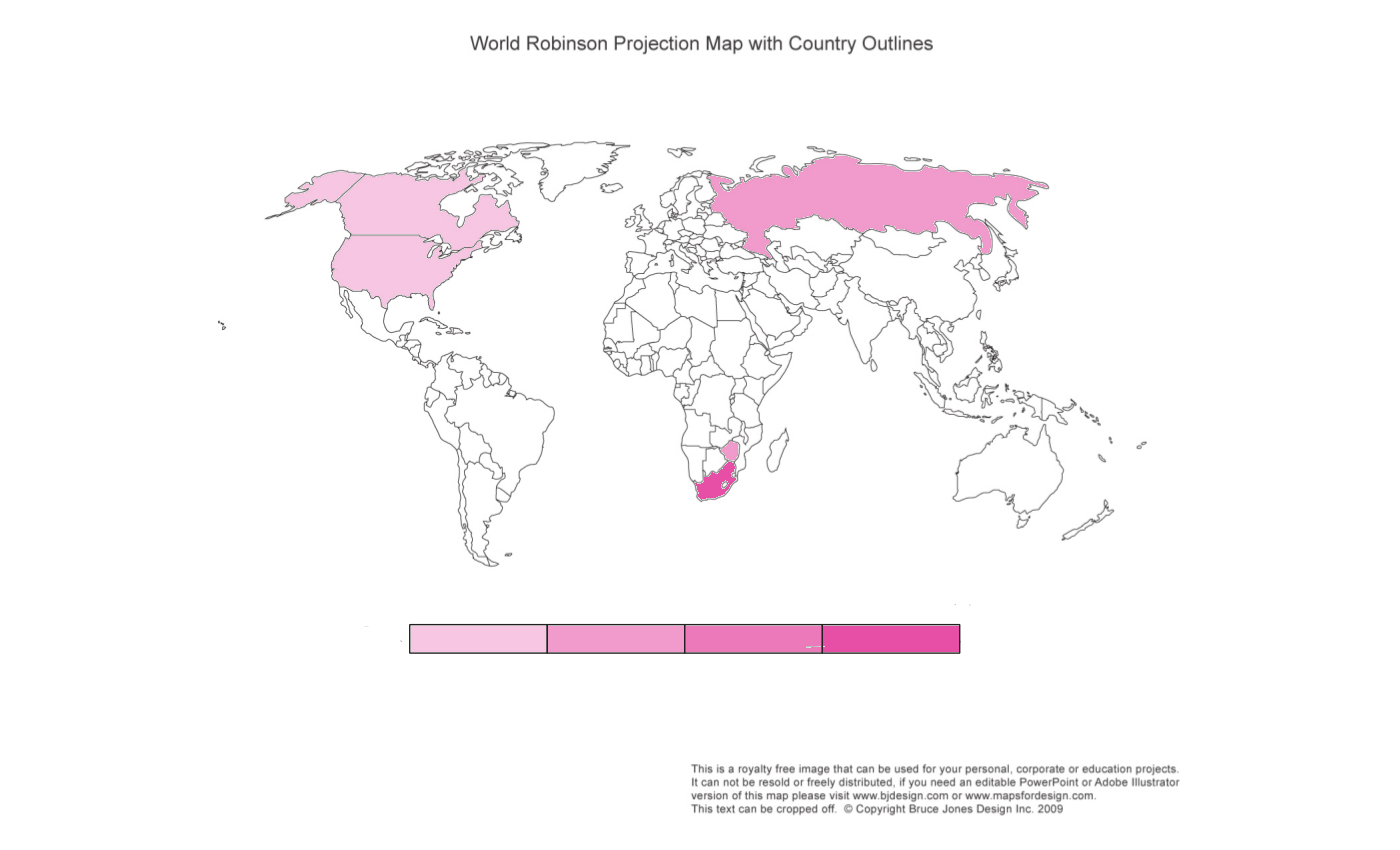
Platinum group elements: http://pubs.usgs.gov/of/2004/1224/2004-1224.pdf
Global Reserve Map for rare earth elements (REEs):
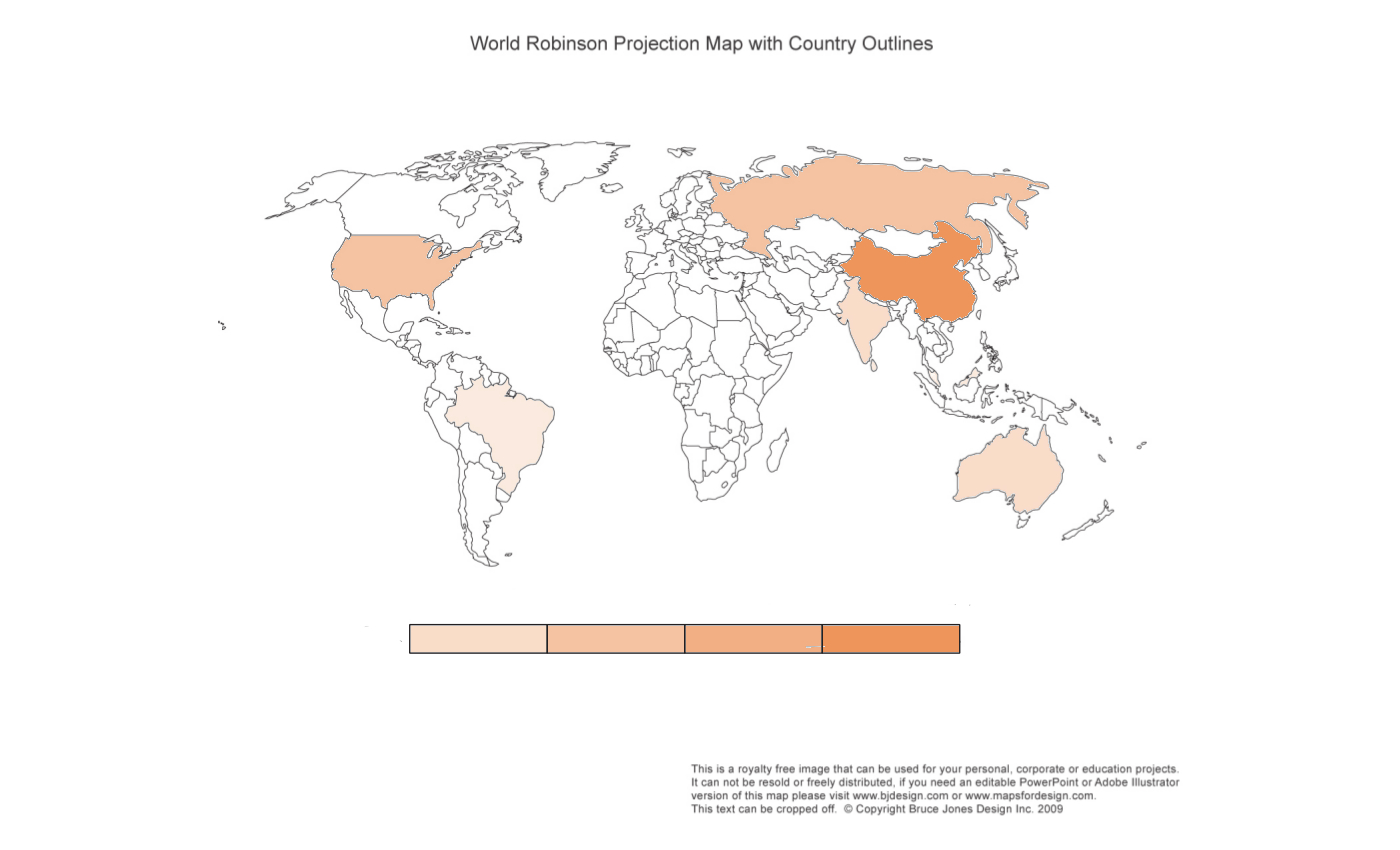
REE: http://www.fas.org/sgp/crs/natsec/R41347.pdf
http://minerals.usgs.gov/minerals/pubs/commodity/rare_earths/mcs-2011-raree.pdf
Global Reserve Map for Rhenium:
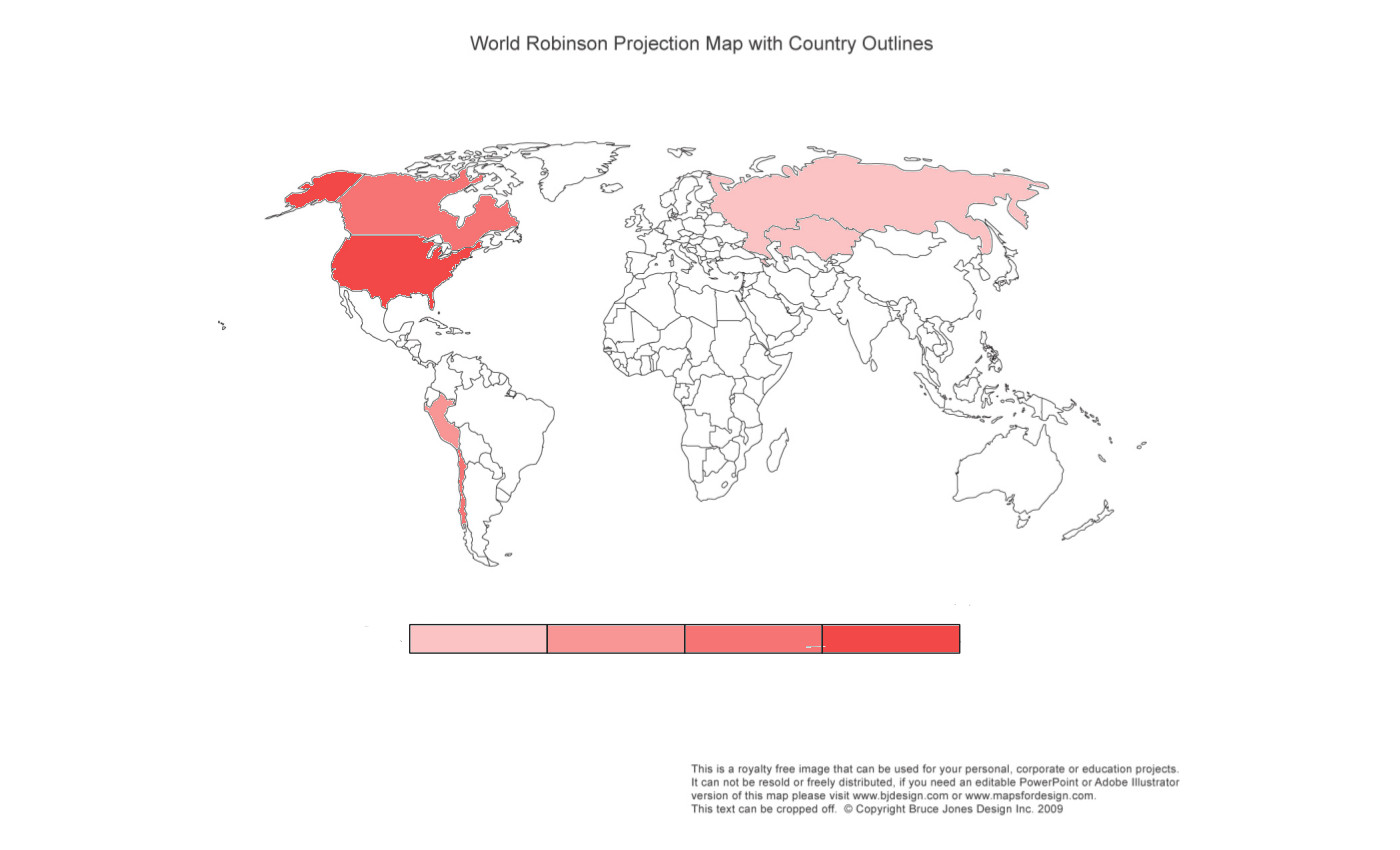
Rhenium: http://minerals.usgs.gov/minerals/pubs/commodity/rhenium/rhenimcs07.pdf
Global Reserve Map for Tantalum:

Tantalum: http://minerals.usgs.gov/minerals/pubs/commodity/niobium/mcs-2012-tanta.pdf
Global Reserve Map for Thorium:
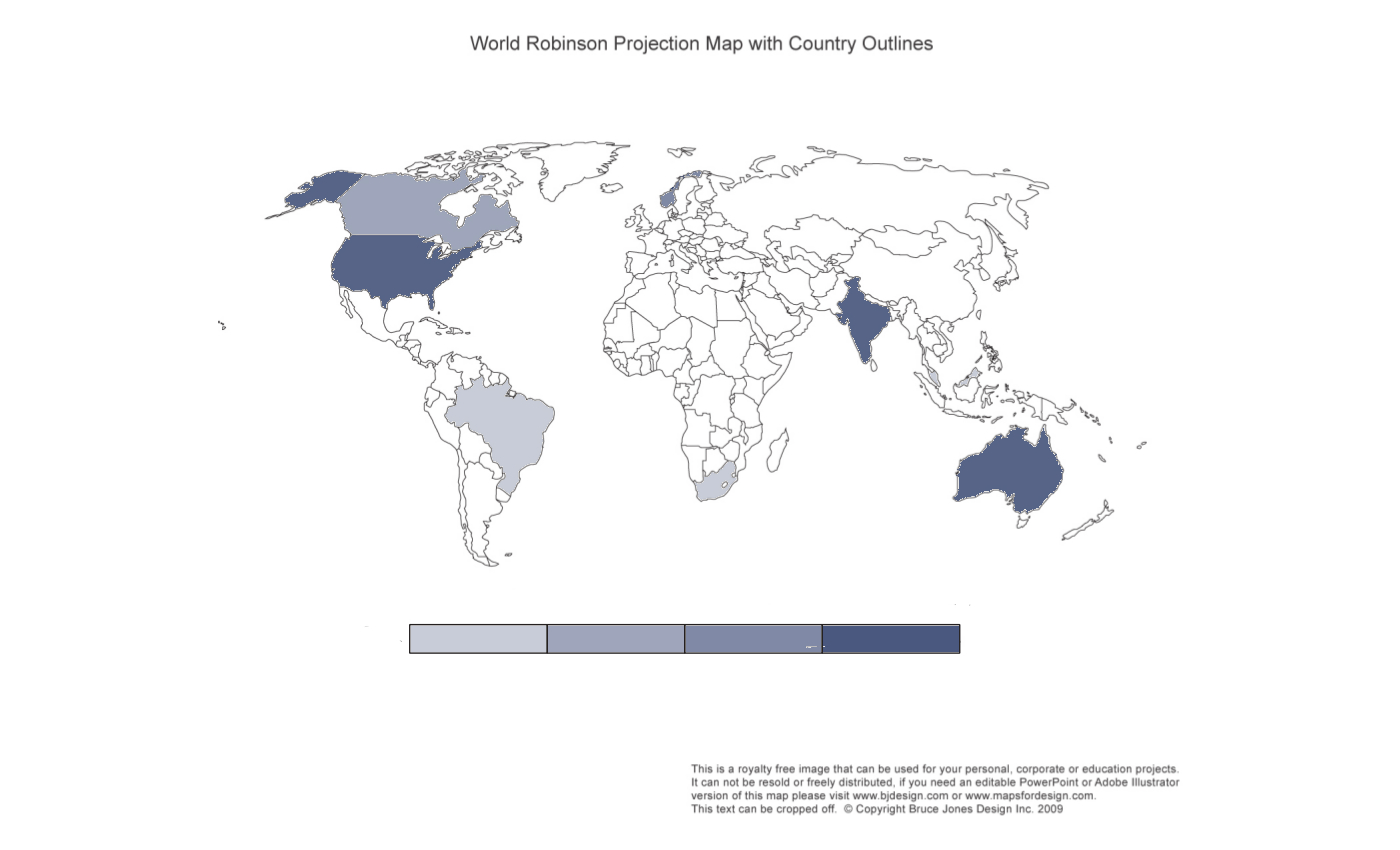
Thorium: http://minerals.usgs.gov/minerals/pubs/commodity/thorium/690397.pdf
Global Reserve Map for Uranium:
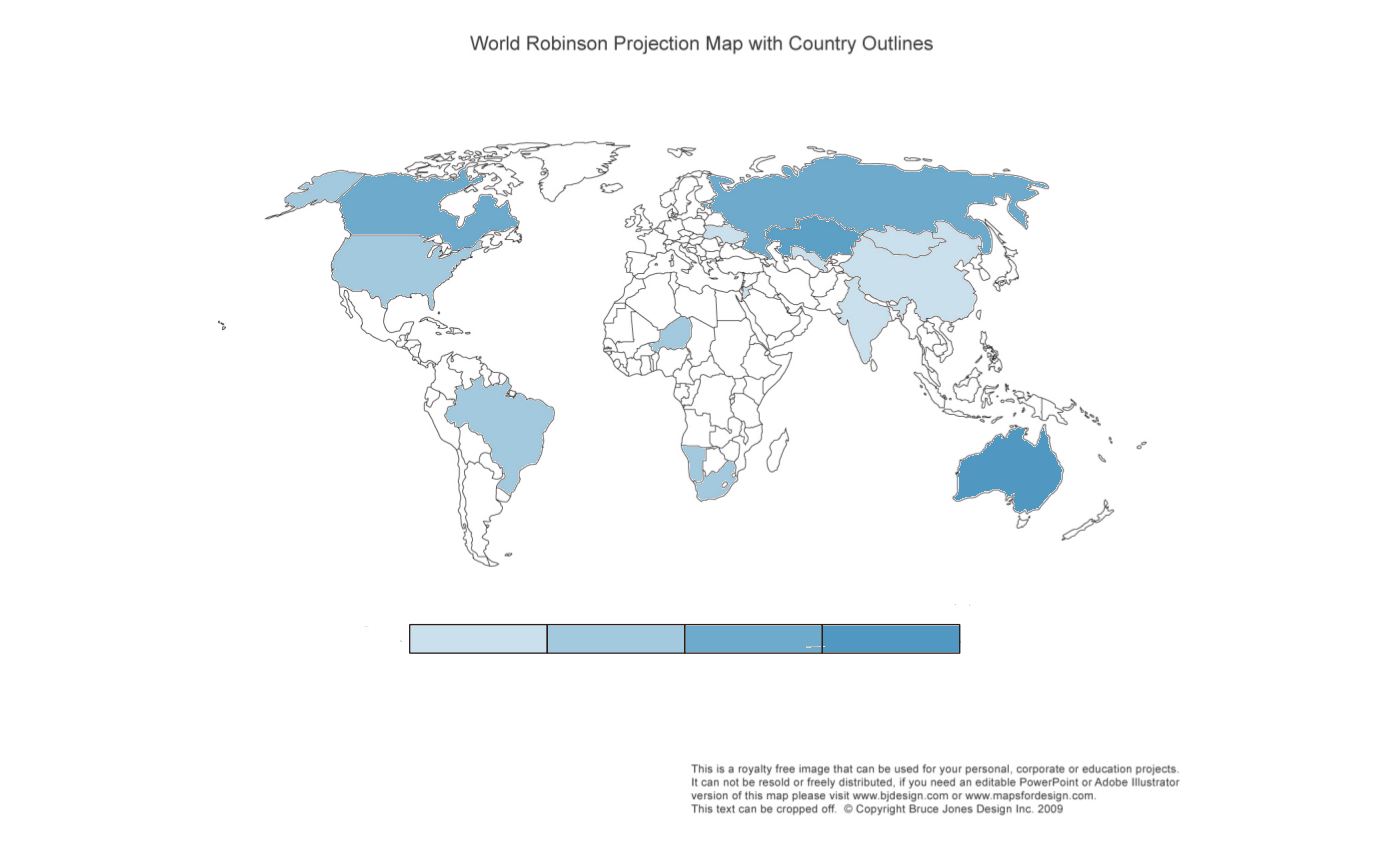
Uranium: http://commons.wikimedia.org/wiki/File:Uranium_Reserves.png
from http://www.world-nuclear.org/info/inf75.html
Global Reserve Map for Yttrium:
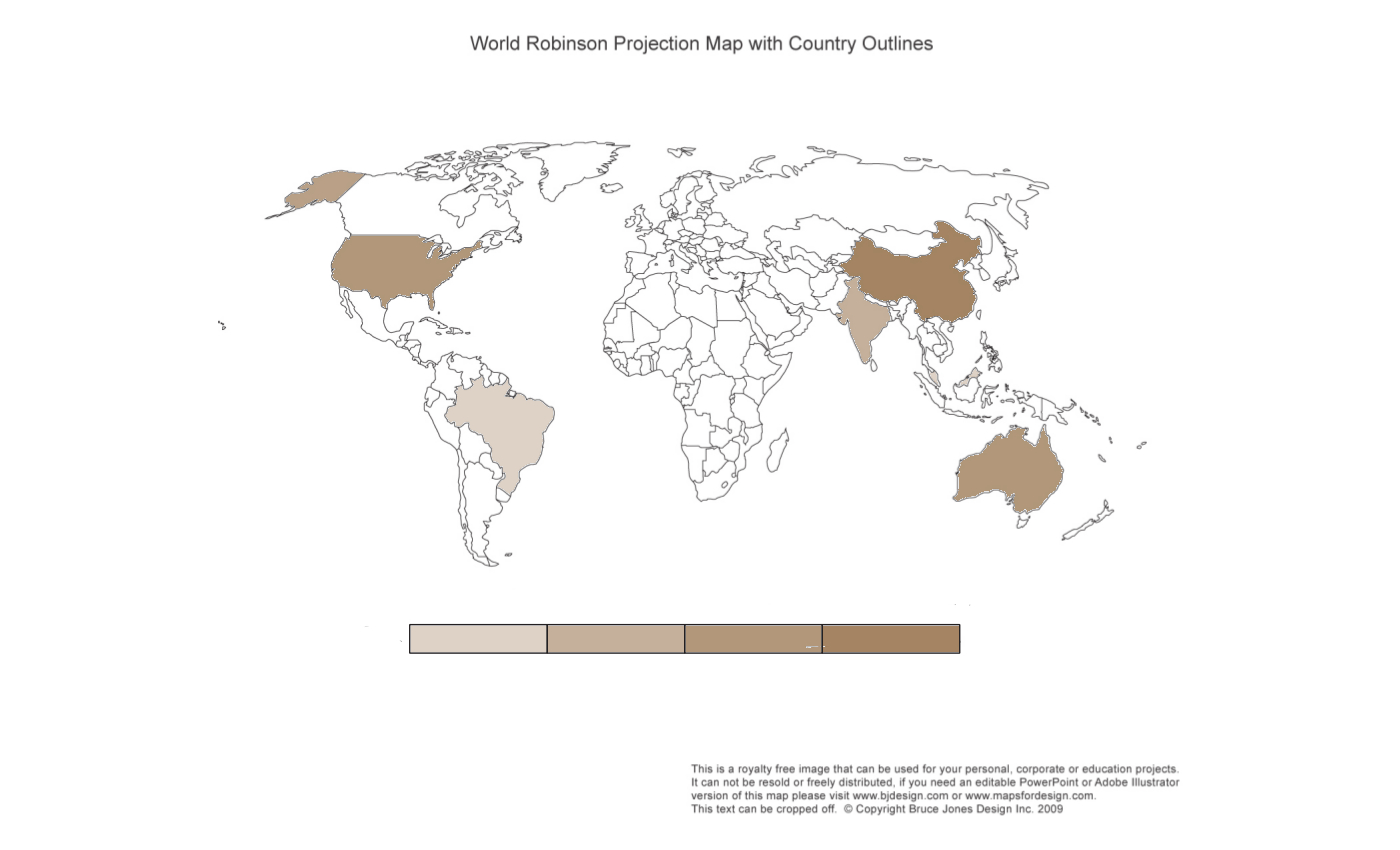
Yttrium: http://minerals.usgs.gov/minerals/pubs/commodity/rare_earths/mcs-2012-yttri.pdf
Beauford, R. (n.d.). Rare Earth Elements - Rare Earth Element Minerals & Ores. Rare Earth Elements - Rare Earth Elements Educational Resources Home Page. Retrieved November 25, 2012, from http://rareearthelements.us/mineral_ores
Fichter, L. S. (2000, October 26). Sedimentary rock classification. Retrieved from http://csmres.jmu.edu/geollab/fichter/SedRx/sedclass.html
Chakhmouradian, A. R. & Wall, F. (2012, October). Rare earth elements: Minerals, mines, magnets (and more). Elements: An International Magazine of Mineralogy, Geochemistry, and Petrology, 8(5),
Goodfellow, W. D. "Consolidation and Synthesis of Mineral Deposits Knowledge.";Natural Resources Canada. N.p.: n.p., 2006. N. pag. Print.
Greenberg, C. (2012, January 9). Salazar bans uranium mining in Grand Canyon area for 20 years — Conservative Outlooks. Conservative Outlooks. Retrieved November 25, 2012, from http://conservative-outlooks.com/2012/01/09/salazar-bans-new-uranium-leases-in-arizona-for-20-years/
Gruber, P. W., Medina, P. A., Keoleian, G. A., Kesler, S. E., Everson, M. P., & Wallington, T. J. (2011). Global lithium availability: A constraint for electric vehicles?. Journal of industrial ecology,
Hein, J. (n.d.). New book edited by USGS marine scientist examines the life cycle of the phosphoria formation. Sound Waves. Retrieved November 25, 2012, fromsoundwaves.usgs.gov/2004/02/pubs.html
Humphries, M. (2012, June 8). Rare earth elements: The global supply chain. Federation of American Scientists. Retrieved November 25, 2012, from http://www.fas.org/sgp/crs/natsec/R41347.pdf
Loferski, Patricia J. Platinum-Group Metals. Rep. N.p.: USGS, 2011. Retrieved November 25, 2012 from http://minerals.usgs.gov/minerals/pubs/commodity/platinum/
Orris, G. J., & Grauch, R. I. (n.d.). Rare Earth Element Mines, Deposits, and Occurrences. USGS Publications Warehouse. Retrieved November 25, 2012, fromhttp://pubs.usgs.gov/of/2002/of02-189/
Pohl, W. (2011). Economic geology: principles and practice : metals, minerals, coal and hydrocarbons - introduction to formation and sustainable exploitation of mineral deposits. Chichester, West Sussex: Wiley-Blackwell.
Prothero, D. R. (2004). Sedimentary geology: An intro to sedimentary rocks and straitagraphy (Second Edition ed.). New York: W.H. Freeman and Company.
Raymond, L. A. (1995). Petrology: the study of igneous, sedimentary, and metamorphic rocks. Dubuque: Wm. C. Brown.
Schroder, J.J., D. Cordell, A.L. Smit, and A. Rosemarin. Sustainable Use of Phosphorous. Rep. no. 357. Retrieved November 25, 2012 from http://ec.europa.eu/environment/natres/pdf/sustainable_use_phosphorus.pdf
Shaw, Suzanne, and Judith Chegwidden. Global Drivers for Rare Earth Demand. N.p.: Roskill Information Services, 2012. Print.
Terry, M. (2011, January 4). Rare Earths - A Brief Summary and Focus Elements - Seeking Alpha. Stock Market News & Financial Analysis - Seeking Alpha. Retrieved November 25, 2012, from http://seekingalpha.com/article/244792-rare-earths-a-brief-summary-and-focus-elements
Thorium Mining. (n.d.). Thorium Reactor Technology. Retrieved November 25, 2012, from http://www.thoriumreactortechnology.com/
Topinka, L. (2007, December 3). CVO Menu - America's Volcanic Past. USGS Cascades Volcano Observatory (CVO). Retrieved November 25, 2012, fromhttp://vulcan.wr.usgs.gov/LivingWith/Volcan
Uranium Supplies: Supply of Uranium. (n.d.). World Nuclear. Retrieved
November 25, 2012, from http://www.world-nuclear.org/info/inf75.html
US. US Department of the Interior, USGS. Mineral Commodity Summaries 2012. Retrieved November 25, 2012 from http://minerals.usgs.gov/minerals/pubs/mcs/2012/mcs2012.pdf
Vaccari, D. A. (2009). Phosphorus: A Looming Crisis. Scientific American, June, 54-59.
Wilburn, David R., and Donald I. Bleiwas. Platinum-Group Metals—World Supply and Demand. Rep. N.p.: USGS, n.d. Print.
Zapata, F., & Roy, R. (n.d.). Use of phosphate rocks for sustainable agriculture. FAO: Food and Agriculture Organization of the United Nations, for a world without hunger. Retrieved November 25, 2012, from http://www.fao.org/docrep/007/y5053e/y5053e07.htm.

